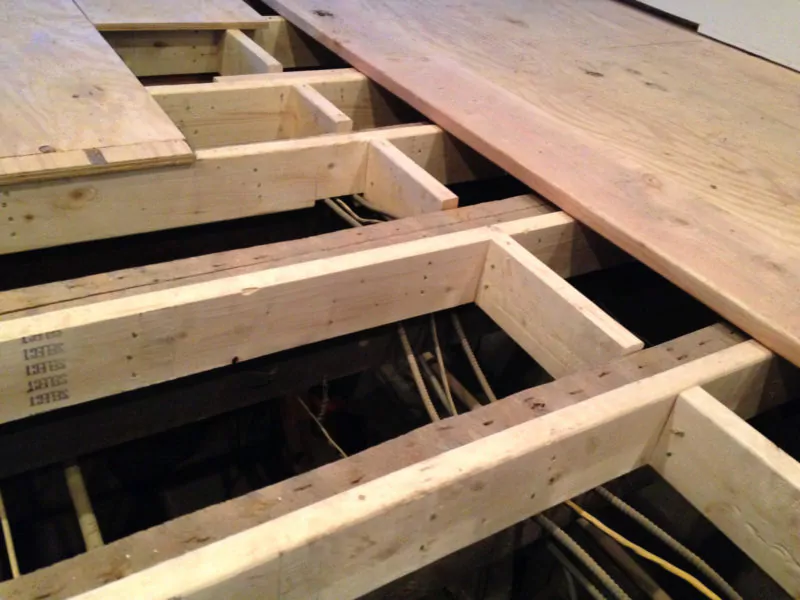Sagging floor joists, the essential beams supporting your home’s flooring, can lead to uneven surfaces, squeaky noises, and even structural instability. Addressing this issue promptly is crucial to preserve the integrity of your home and ensure its safety. This comprehensive guide will equip you with the knowledge and step-by-step instructions to tackle this repair effectively.

Image: www.moneypit.com
Understanding Floor Joists and Their Importance
Floor joists are horizontal beams installed perpendicular to the home’s foundation and support the subflooring and flooring above. They distribute the weight of your furniture, appliances, and occupants throughout the structure. Over time, heavy loads, moisture damage, or faulty construction can weaken these joists, causing them to sag and compromising the stability of your floor.
Signs of Sagging Floor Joists
- Uneven flooring: Carpets may appear loose or wavy, and tiles may crack or shift.
- Squeaky noises: Movement between the joists and subflooring can create annoying squeaks when you walk across the floor.
- Bowing walls: Excessive weight or sagging joists can put pressure on the exterior walls, causing them to bow inward.
- Door and window misalignment: Doors may stick or become difficult to close, and windows may not fit properly in their frames.
Determining the Extent of Damage
Before embarking on the repair process, you need to assess the severity of the sagging. Measure the distance between the joist and a taut string tied at both ends. If the deflection exceeds 1/360 of the joist’s length, you have a significant issue requiring immediate attention.

Image: www.familyhandyman.com
Step-by-Step Repair Guide
Materials Needed:
- New floor joists (size and length to match existing)
- Lumber screws
- Structural glue
- Drill
- Circular saw
- Level
- Jack studs
Steps:
-
Safety First: Ensure your work area is well-ventilated and wear appropriate protective gear, including safety glasses and work gloves.
-
Locate Joist: Determine the exact location of the sagging joist by removing a small section of drywall.
-
Install Jack Studs: Place two jack studs on either side of the sagging joist, spaced about 2-3 feet apart. Use a level to ensure they are vertical.
-
Inspect and Measure: Check the existing joist for damage, such as cracks or rot. Measure the distance between the sagging joist and the adjacent joists.
-
Cut New Joists: Cut new joists to the same length as the damaged one, ensuring they are of equal or greater capacity.
-
Position New Joists: Place the new joists parallel to the existing one, spaced evenly apart. Secure them with structural glue and lumber screws.
-
Lift the Floor: Using a hydraulic jack or manual jacks, lift the joist assembly slightly to separate it from the subflooring.
-
Slide in New Joists: Slide the new joists into place, ensuring they fit snugly between the jack studs and the subflooring above.
-
Secure Joists: Use lumber screws to securely fasten the new joists to the existing ones. Double-check the alignment using a level.
-
Lower Floor: Carefully lower the joist assembly back into place. Remove the jacks once the floor is fully supported.
-
Inspect and Reinforce: If the other joists show signs of weakness, consider adding sister joists to reinforce them. Sister joists are additional joists installed alongside existing ones to provide extra support.
-
Patch Drywall: Replace the section of drywall you removed earlier and patch any other areas that may have been damaged during the repair.
How To Fix Sagging Floor Joists
Additional Tips for Sagging Floor Joist Repair
- For spans exceeding 12 feet, consider consulting with a structural engineer for professional advice.
- Use high-quality materials and follow manufacturer’s instructions carefully.
- Allow for adequate drying time for any glue or adhesives used.
- Reinforce the subflooring above the repaired joists by adding additional plywood or OSB sheets.
- If you encounter extensive damage or structural instability, it is recommended to contact a qualified contractor.
By following these steps and adhering to these tips, you can effectively restore the structural integrity of your sagging floor joists, ensuring a solid and safe foundation for your home. Remember, proper maintenance and regular inspections can help prevent such issues from occurring in the future.